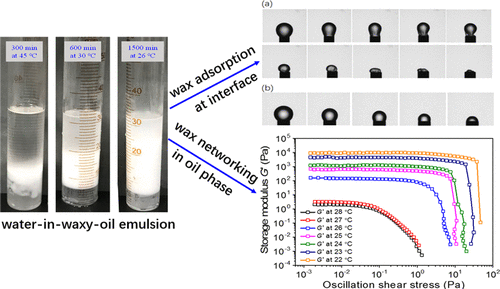当前位置:
X-MOL 学术
›
Energy Fuels
›
论文详情
Our official English website, www.x-mol.net, welcomes your
feedback! (Note: you will need to create a separate account there.)
Characterization of the Precipitation Modes of Paraffin Wax in Water-in-Model-Oil Emulsions
Energy & Fuels ( IF 5.2 ) Pub Date : 2020-11-25 , DOI: 10.1021/acs.energyfuels.0c02902 Yujiang Li 1 , Chuanxian Li 1, 2 , Guangyu Sun 1, 2 , Xinya Chen 1 , Daiwei Liu 1 , Fei Yang 1, 2 , Bo Yao 1, 2 , Yansong Zhao 3
Energy & Fuels ( IF 5.2 ) Pub Date : 2020-11-25 , DOI: 10.1021/acs.energyfuels.0c02902 Yujiang Li 1 , Chuanxian Li 1, 2 , Guangyu Sun 1, 2 , Xinya Chen 1 , Daiwei Liu 1 , Fei Yang 1, 2 , Bo Yao 1, 2 , Yansong Zhao 3
Affiliation

|
The precipitation of wax crystals in water-in-crude-oil emulsion impairs the safety and economy of multiphase transportation in oil fields. At present, there are different opinions on the precipitation modes of paraffin wax. Existing studies mostly use microscopic observation to determine whether wax crystals are adsorbed at the oil–water interface. In this study, the precipitation modes of paraffin wax in water-in-model-oil emulsions were comprehensively investigated by combining calorimetry, drop shape analysis, and rheology. It was found by differential scanning calorimetry that the presence of water droplets could slightly increase the wax precipitation temperature (WPT), reflecting the function of the interface as nucleation sites. Further, by adopting the drop shape analysis experiment and calculating the interfacial tension and interfacial dilational modulus based on it at the temperatures above and below the WPT, it was confirmed that wax crystals did adsorb at the interface and forced the interface to solidify, causing the interface to wrinkle when shrinking. Then, the results of the bulk viscoelasticity test proved the precipitation of wax crystals in the continuous oil phase and the formation of a network structure, which made the emulsion gelatinize and show strong viscoelasticity and yield characteristics. Finally, it was concluded that wax crystals not only precipitate in the oil phase but also precipitate and adsorb at the interface.
中文翻译:

模型油包水型乳化液中石蜡蜡的沉淀模式表征
油包水型乳状液中蜡晶体的沉淀损害了油田多相运输的安全性和经济性。目前,对于石蜡的沉淀方式有不同的看法。现有研究大多使用显微镜观察来确定蜡晶体是否吸附在油水界面上。在这项研究中,结合量热法,液滴形状分析和流变学,对石蜡在油包水型乳液中的沉淀模式进行了全面研究。通过差示扫描量热法发现,水滴的存在会稍微增加蜡的沉淀温度(WPT),反映出界面作为成核位点的功能。进一步,通过采用液滴形状分析实验并在WPT之上和之下的温度下基于其计算界面张力和界面膨胀模量,可以确认蜡晶体确实在界面处吸附并迫使界面凝固,从而导致界面凝固。皱时收缩。然后,本体粘弹性试验的结果证明了蜡晶体在连续油相中的沉淀和网络结构的形成,这使乳液胶凝并显示出强的粘弹性和屈服特性。最后,得出结论,蜡晶体不仅在油相中沉淀,而且在界面处沉淀并吸附。证实蜡晶体确实在界面处吸收并迫使界面固化,从而导致界面在收缩时起皱。然后,本体粘弹性测试的结果证明了蜡晶体在连续油相中的沉淀和网络结构的形成,这使乳液胶凝并显示出强的粘弹性和屈服特性。最后,得出结论,蜡晶体不仅在油相中沉淀,而且在界面处沉淀并吸附。证实蜡晶体确实吸附在界面上并迫使界面固化,从而导致界面在收缩时起皱。然后,本体粘弹性测试的结果证明了蜡晶体在连续油相中的沉淀和网络结构的形成,这使乳液胶凝并显示出强的粘弹性和屈服特性。最后,得出结论,蜡晶体不仅在油相中沉淀,而且在界面处沉淀并吸附。使乳液胶凝并显示出强的粘弹性和屈服特性。最后,得出结论,蜡晶体不仅在油相中沉淀,而且在界面处沉淀并吸附。使乳液胶凝并显示出强的粘弹性和屈服特性。最后,得出结论,蜡晶体不仅在油相中沉淀,而且在界面处沉淀并吸附。
更新日期:2020-12-17
中文翻译:

模型油包水型乳化液中石蜡蜡的沉淀模式表征
油包水型乳状液中蜡晶体的沉淀损害了油田多相运输的安全性和经济性。目前,对于石蜡的沉淀方式有不同的看法。现有研究大多使用显微镜观察来确定蜡晶体是否吸附在油水界面上。在这项研究中,结合量热法,液滴形状分析和流变学,对石蜡在油包水型乳液中的沉淀模式进行了全面研究。通过差示扫描量热法发现,水滴的存在会稍微增加蜡的沉淀温度(WPT),反映出界面作为成核位点的功能。进一步,通过采用液滴形状分析实验并在WPT之上和之下的温度下基于其计算界面张力和界面膨胀模量,可以确认蜡晶体确实在界面处吸附并迫使界面凝固,从而导致界面凝固。皱时收缩。然后,本体粘弹性试验的结果证明了蜡晶体在连续油相中的沉淀和网络结构的形成,这使乳液胶凝并显示出强的粘弹性和屈服特性。最后,得出结论,蜡晶体不仅在油相中沉淀,而且在界面处沉淀并吸附。证实蜡晶体确实在界面处吸收并迫使界面固化,从而导致界面在收缩时起皱。然后,本体粘弹性测试的结果证明了蜡晶体在连续油相中的沉淀和网络结构的形成,这使乳液胶凝并显示出强的粘弹性和屈服特性。最后,得出结论,蜡晶体不仅在油相中沉淀,而且在界面处沉淀并吸附。证实蜡晶体确实吸附在界面上并迫使界面固化,从而导致界面在收缩时起皱。然后,本体粘弹性测试的结果证明了蜡晶体在连续油相中的沉淀和网络结构的形成,这使乳液胶凝并显示出强的粘弹性和屈服特性。最后,得出结论,蜡晶体不仅在油相中沉淀,而且在界面处沉淀并吸附。使乳液胶凝并显示出强的粘弹性和屈服特性。最后,得出结论,蜡晶体不仅在油相中沉淀,而且在界面处沉淀并吸附。使乳液胶凝并显示出强的粘弹性和屈服特性。最后,得出结论,蜡晶体不仅在油相中沉淀,而且在界面处沉淀并吸附。










































 京公网安备 11010802027423号
京公网安备 11010802027423号